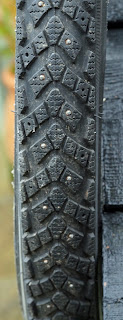I made the schoolboy error of
whipping the Pro Stealth Saddle in situ, making cursory visual inspection and
checked alignment with a straight edge (rather than a spirit level).
Subsequently, I paid the price, 20 miles into our maiden voyage, my sit bones
were screaming.
However, being a seasoned
tester of traditional leather saddles, I persevered. Fifteen miles into our
second outing, my inner thigh was feeling decidedly raw. I concluded, mid ride
that the saddle height was fractionally too low, with the Stealth.
This, (coupled with the
padding density) in turn was placing additional pressure, causing this
discomfort. Relieved to be home, time for a more detailed
analysis. I produced a 5mm Allen key and raised the seat post by a few millimetres,
then took a spirit level to things. Not far out but sufficient…Loosening the cradle
bolt, tilting the saddle fractionally downwards, snugging the cradle bolt tight
(while keeping a sharp eye on the level) cured this.
My Univega was sporting a fair
amount of slimy, salty road filth and the Juice Lubes Ceramic Juice was looking
a bit filmy. This prompted a quick cold-water rinse, followed by a sudsy bucket
and drivetrain cleansing
White Lightning Extreme Wet
was the most obvious, default replacement. No curing time, plenty of staying
prowess-should last through February. Delivering a few squirts of Juice Lubes
JL69 Bike Maintenance Spray https://www.sevendaycyclist.com/juice-lubes-jl to
cables and pivot points concluded said fettling episode…
Then I spotted some nasty
looking sharps that had penetrated its rear Schwalbe Marathon Mondial Double
Defence Tyres https://www.sevendaycyclist.com/schwalbe-marathon-mondial-tyres.
Deflated the tyre, extracted the flints using nail tweezers, then filled the
holes with superglue.
Oddly enough, some Tannus Tyre
Liners had arrived for testing (although these were 700x32, so went to the
Schwalbe Road Cruiser https://www.sevendaycyclist.com/scwalbe-road-cruiser-tyres
Fortuitous too, since the Schwalbe had also succumbed to a flint induced flat.
Liner protectors work like
another layer within the tyre, preventing thorns and similar sharps puncturing
the tube. I recall Tuffy Tape from the late 80s. Some swore by it, others at
it.
Those taking a more moderate
(dare I say, rational) stance suggested they could work well but recommended
checking their alignment periodically. This was to prevent them inducing
precisely the flats they were intended to eliminate.
These Tannus are less
convenient to install than heavy duty butyl. They cite an additional 40
seconds. Maybe with assembly line familiarity but I took another 2/3 minutes
first time round. Still, at 200g apiece, are considerably lighter than the
Kenda Thornproof tubes (which have been my defaults during winter’s worst for
nigh on a decade).
Retailing at £29.99, the
Tannus are pretty much the going rate for liner technology. That said; money
would be better spent on upgrading tyres, if you’re running unreliable budget
rubber, or a higher end set are past their prime. Tannus also reckon it’s possible to limp home
on an otherwise flat tyre, without damaging the rim.
Taking this a stage further,
this theoretically allows tyres to be run at really low pressures, say for
additional grip on the trails, or a really icy road. Personally, in the latter
context, I would’ve reached for the Schwalbe Marathon winter https://www.sevendaycyclist.com/schwalbe-winter-spiked-tyre, or
comparable spiked tyre.
Back to saddles, I was still
feeling a little raw, so switched exclusively to my fixed gear winter trainer
and the Selle San Marco Concor SuperCorsa for a few days. Now, as I’ve said
before, in some respects, it’s an old saddle but serves to illustrate that
classic designs are still very relevant.
Yes, 320g might be a touch
portly for some (those with bikes on Calorie controlled diets, in particular)
but what’s a few grams if you can sit in comfort all day? Arguably, black would’ve been a better fit
with my working fixed’s colour scheme. I reckon the tan’s a nice contrast.
The Genetic D-Riser 4 Bars
continue to impress me. For gravel/cyclo cross I’d stick with their D-Riser 16
siblings https://www.sevendaycyclist.com/genetic-d-riser-bars,
which still perform very well on asphalt.
However, I have been surprised to
find the D-Riser 4 feel that bit sharper on relatively smooth roads-sweeping
around S bend descents that kind of thing.
I haven’t noticed any real
difference, when ascending and as with its sibling the 20degree rise is subtle
but welcome, especially through congested traffic, or relaxing on a long day
ride. I'll do a few hundred miles more with these contact points, before reaching any firm conclusions.








































